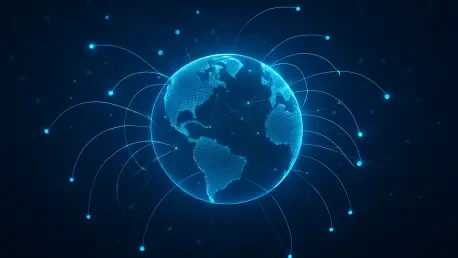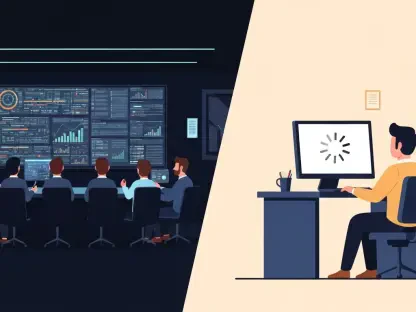In an era where digital access underpins nearly every aspect of modern life—from education and healthcare to economic development—the state of internet connectivity in U.S. Tribal Nations demands urgent attention. Across 110 Tribal communities, the digital landscape reveals a striking mix of progress and profound challenges, as detailed in extensive data gathered by Ookla® Speedtest® over recent years. While some Tribes have harnessed funding and partnerships to achieve internet speeds that rival or surpass those of neighboring states, others remain trapped in a digital void, struggling with connectivity that falls far below federal benchmarks. This disparity not only highlights the broader digital divide but also underscores the unique barriers faced by these communities, often rooted in geography and systemic inequities. The journey toward digital equity in Tribal Nations is complex, shaped by a blend of innovative solutions and persistent obstacles that vary widely from one community to another. As technology continues to reshape societal structures, understanding and addressing these connectivity gaps becomes not just a matter of infrastructure, but a critical step toward ensuring equal opportunities for all.
The narrative of connectivity in Tribal areas is one of contrasts, where inspiring success stories coexist with stark reminders of inequality. Federal initiatives and collaborative efforts have sparked transformative change in certain regions, yet many Tribes grapple with hurdles that slow or stall progress. This exploration aims to unpack the factors driving these disparities, from geographical isolation to funding challenges, while spotlighting the strategies that have yielded tangible results. By delving into both the struggles and triumphs, a clearer picture emerges of what it will take to bridge the digital divide in these often-overlooked communities.
Challenges Facing Digital Access
In today’s rapidly evolving technological landscape, ensuring equitable digital access remains a significant challenge for many communities, particularly in underserved and rural areas where infrastructure and resources are often limited. Addressing these disparities requires innovative solutions and collaborative efforts from both public and private sectors to bridge the digital divide effectively.
Geographical Barriers
Rural Isolation and Infrastructure Costs
Many Tribal Nations, particularly those in remote and rural regions like Alaska, confront formidable challenges in securing reliable internet access due to their geographical isolation, which often limits their connection to the broader digital world. The rugged terrain and vast distances characteristic of these areas significantly complicate the deployment of essential infrastructure, such as fiber optic cables or cell towers. Low population density further exacerbates the issue, as it diminishes the financial incentive for private companies to invest in building out networks where the return on investment is uncertain. For Tribes in such locations, the result is often internet speeds that fall well below national standards, limiting access to critical services like telehealth and online education. The high cost of logistics, coupled with environmental challenges like permafrost or harsh weather, means that even when funding is available, implementation can be a slow and arduous process. This isolation creates a vicious cycle, where lack of connectivity hinders economic growth, which in turn makes infrastructure investment less viable.
Vulnerability of Existing Systems
Beyond the initial hurdles of building infrastructure, many Tribal Nations in isolated areas face ongoing issues with the reliability and maintenance of existing systems, particularly in regions like Alaska where challenges are pronounced. In Alaska, for instance, some Tribes depend on subsea fiber optic cables that are prone to damage from natural events or human activity, leading to frequent service disruptions. The cost of repairs in such remote locations is prohibitively high, often leaving communities without internet for extended periods. This vulnerability underscores a deeper problem: even when connectivity solutions are in place, they are not always sustainable without significant ongoing support. The lack of local technical expertise to address these issues further compounds the challenge, as Tribes must often rely on external providers who may not prioritize rapid response in sparsely populated regions. This fragility of digital access serves as a constant reminder of the structural barriers that persist beyond initial deployment.
Systemic Obstacles
Administrative and Funding Complexities
Despite the availability of substantial federal funding through programs like the Tribal Broadband Connectivity Program (TBCP), many Tribal Nations struggle to navigate the intricate administrative processes required to secure these resources. Complex grant applications often demand a level of bureaucratic expertise and documentation that can be out of reach for smaller or under-resourced communities. Even when funding is awarded, delays in implementation—such as those faced by the Mashantucket Pequot Tribal Nation, with project completion pushed to 2026—can stall progress for years. These delays not only hinder immediate access to better connectivity but also erode trust in the systems meant to support Tribal development. The administrative burden, often coupled with a lack of clarity on how to meet federal requirements, creates a bottleneck that prevents many communities from translating available funds into tangible improvements.
Technical Expertise and Investment Gaps
Another significant barrier lies in the scarcity of technical know-how within many Tribal Nations to design, implement, and maintain advanced connectivity infrastructure. Building high-speed internet networks requires specialized skills that may not be readily available in communities already grappling with limited resources, creating a significant challenge for progress. This gap in expertise often forces Tribes to depend on external contractors or partners, which can lead to higher costs and misaligned priorities. Additionally, the low population density in many Tribal areas deters private investment, as telecom companies see little profit potential in serving small, dispersed populations. Without sufficient internal capacity or external interest, many Tribes find themselves stuck with outdated technologies like DSL or satellite internet, which fail to meet modern demands. This systemic lack of technical and financial support perpetuates a cycle of digital exclusion that is difficult to break without targeted intervention.
Pathways to Digital Progress
Impact of Funding and Partnerships
Federal Support as a Catalyst
Federal programs such as the TBCP and the Broadband Equity, Access, and Deployment (BEAD) initiative have emerged as vital lifelines for enhancing connectivity in Tribal Nations, channeling significant resources into underserved areas. With TBCP alone allocating $1.8 billion to 226 Tribal entities by last year, the scale of investment reflects a growing recognition of the digital divide’s impact on these communities. Where these funds have been effectively deployed, the results are striking—some Tribes have achieved gigabit fiber speeds that outpace state averages, enabling access to transformative services like remote learning and telemedicine. However, the success of such programs often hinges on the ability of Tribal governments to manage and sustain these projects over time. The federal push, while substantial, must be paired with streamlined processes to ensure that resources reach the communities most in need without unnecessary delays or bureaucratic friction.
Collaborative Models Driving Change
Partnerships with private companies and utility providers have proven to be a game-changer for many Tribal Nations seeking to overcome connectivity challenges. A prime example is the Zuni Tribe in New Mexico, which collaborated with the Continental Divide Electric Cooperative to secure a $4.4 million grant, resulting in fixed download speeds of 458.1 Mbps—more than double the state average. Such alliances leverage external expertise and infrastructure, allowing Tribes to bypass some of the financial and technical barriers to building networks from scratch. These collaborations often fill critical gaps where federal funding alone is insufficient, providing a scalable model for other communities to emulate. By sharing costs and resources, Tribes can achieve rapid improvements in internet access, paving the way for broader economic and social benefits that come with reliable connectivity.
Community-Driven Innovations
Leveraging Local Economic Strengths
Some Tribal Nations have turned inward, using their own economic resources to drive digital advancements, demonstrating the power of self-sufficiency in overcoming connectivity barriers. The Shakopee Mdewakanton Sioux Community in Minnesota stands out, having invested revenue from gaming and resort enterprises into cutting-edge 5G infrastructure, achieving download speeds of 468.42 Mbps—far surpassing the state average. This approach highlights how local wealth, when strategically directed, can fuel technological progress independent of external funding cycles. By prioritizing connectivity as a cornerstone of community development, such Tribes not only improve access for their members but also set a precedent for how economic self-reliance can translate into digital equity. The success of these initiatives often inspires neighboring communities to explore similar paths, creating a ripple effect of innovation.
Grassroots Efforts and Cultural Alignment
Beyond financial investments, many Tribes are fostering connectivity through grassroots efforts that align with their cultural values and community needs. Local initiatives often focus on ensuring that digital solutions serve specific purposes, such as preserving language through online platforms or supporting traditional businesses with e-commerce tools. These efforts prioritize community engagement, ensuring that technology adoption is not just imposed but embraced as a tool for empowerment. By involving Tribal members in the planning and execution of connectivity projects, these initiatives build trust and foster a sense of ownership over the infrastructure. This culturally grounded approach contrasts with top-down models, offering a sustainable framework that respects Tribal sovereignty while addressing practical needs. The result is a connectivity landscape that reflects the unique identity and priorities of each community.
Strategies for Infrastructure Development
Diverse Approaches to Control
Balancing Autonomy and Collaboration
The ownership of telecom infrastructure represents a critical decision point for Tribal Nations, with models ranging from full control to strategic partnerships shaping the trajectory of connectivity. Tribes like the Yurok have opted for complete ownership of their networks, establishing entities such as Yurok Telecommunications to ensure autonomy over service quality and revenue streams. This approach, while resource-intensive, grants unparalleled decision-making power, allowing communities to tailor solutions to their specific needs. In contrast, other Tribes choose to collaborate with external providers, sharing the burden of costs and technical demands while sacrificing some control. These varied strategies reflect the diverse priorities and capacities across Tribal Nations, each seeking a balance between independence and practicality in building sustainable digital networks.
Revenue Models and Service Quality
The choice of infrastructure ownership significantly influences how Tribes generate revenue and maintain service standards, creating a direct link between control and long-term outcomes. Leasing land to major carriers for mobile services, a common practice among many Tribes, provides a steady income stream but often limits influence over the quality or coverage of connectivity. This trade-off can result in inconsistent service, particularly in remote areas where carriers prioritize profit over comprehensive access. Conversely, Tribes that manage their own infrastructure can reinvest profits directly into upgrades, though they must bear the upfront costs and ongoing maintenance challenges. Navigating these options requires a careful assessment of financial resources and community goals, as the right model can either reinforce digital equity or perpetuate dependency on external entities.
Emerging Opportunities
Spectrum Licensing as a New Frontier
A promising avenue for enhancing connectivity lies in the FCC’s Rural Tribal Priority Window, which allows Tribes to acquire spectrum licenses for self-managed wireless services. This initiative offers the potential for greater independence in mobile connectivity, enabling communities to design networks that prioritize local needs over commercial interests. While the full impact of this program is still unfolding, early adopters are exploring ways to leverage spectrum ownership to improve 5G access in areas overlooked by major carriers. The opportunity to control wireless services could be transformative, particularly for remote Tribes struggling with mobile speeds, though it demands significant investment in technical capacity and infrastructure. As more communities engage with this option, it may redefine how Tribal Nations approach digital sovereignty.
Adapting to Future Technologies
Looking ahead, Tribal Nations must also prepare for the integration of emerging technologies that could further reshape the connectivity landscape. Innovations such as low-earth-orbit satellite networks and next-generation wireless protocols hold promise for overcoming geographical barriers, particularly in isolated regions where traditional infrastructure is impractical. However, adopting these solutions requires forward-thinking policies and partnerships to ensure affordability and accessibility. Tribes that position themselves to experiment with and adapt to these advancements may gain a competitive edge in closing the digital divide. The challenge lies in aligning these technologies with community priorities, ensuring that future-focused strategies do not overlook the immediate needs of underserved populations. This proactive stance could set the stage for long-term digital resilience.
Bridging the Digital Divide
Fixed Broadband Gaps
Stark Contrasts in Performance
The disparities in fixed broadband access across Tribal Nations paint a vivid picture of the digital divide, with performance metrics revealing both remarkable achievements and profound shortcomings. While 36.4% of the 110 analyzed Tribal communities fall below the FCC’s benchmark of 100 Mbps for download speeds, others shatter expectations with exceptional results. The Zuni Tribe, for instance, achieves a staggering 458.1 Mbps, more than doubling New Mexico’s state average, thanks to targeted investments in fiber infrastructure. Meanwhile, the Mashantucket Pequot Tribal Nation in Connecticut languishes at just 6.15 Mbps, a figure that starkly contrasts with the state’s 332.92 Mbps average. These extremes illustrate how access to high-speed internet remains uneven, often tied to the availability of resources and strategic initiatives. The gap in fixed broadband not only affects daily life but also limits opportunities for economic and educational advancement in struggling communities.
Underlying Causes of Inequality
Digging deeper into the causes of these disparities reveals a web of interconnected factors that perpetuate inequality in fixed broadband access. Geographical challenges play a significant role, as remote Tribes often rely on outdated technologies like DSL or satellite internet due to the prohibitive cost of deploying fiber in low-density areas. Additionally, historical underinvestment and limited access to federal grants exacerbate the problem for communities lacking the administrative capacity to secure funding. Even when resources are allocated, implementation delays—stemming from logistical hurdles or regulatory complexities—can stall progress indefinitely. Addressing these root causes requires not just financial support but also tailored solutions that account for the unique circumstances of each Tribe. Without such interventions, the divide in fixed broadband will continue to widen, leaving some communities perpetually behind.
Mobile Connectivity Variations
5G Disparities Across Regions
Mobile connectivity, particularly with the advent of 5G, further underscores the uneven digital landscape within Tribal Nations, where performance varies dramatically from one community to the next. Of the Tribes analyzed, 47 record median 5G download speeds below 100 Mbps, falling short of modern expectations for mobile access. In sharp contrast, the Shakopee Mdewakanton Sioux Community in Minnesota achieves an impressive 468.42 Mbps, significantly outpacing the state’s 285.05 Mbps average, driven by strategic investments in infrastructure. Meanwhile, Alaskan Tribes such as Barrow (Utqiaġvik) struggle with single-digit upload speeds, reflecting the immense challenges of delivering mobile services in remote, harsh environments. These disparities highlight how mobile connectivity, often seen as a more flexible solution than fixed broadband, still faces significant barriers in reaching all Tribal communities equitably.
Barriers to Mobile Network Expansion
The obstacles to expanding mobile networks in Tribal areas are multifaceted, rooted in both physical and economic realities that complicate widespread 5G rollout. In isolated regions, the lack of existing infrastructure means that building cell towers or deploying small cells is a costly endeavor, often beyond the budget of smaller Tribes without external support. Additionally, the reliance on leasing land to major carriers for mobile services can result in uneven coverage, as providers focus on more profitable urban areas rather than rural Tribal lands. The high cost of spectrum licenses and the technical expertise needed to manage independent mobile networks further limit the ability of many Tribes to take control of their connectivity. Overcoming these barriers demands innovative financing models, increased federal assistance, and policies that prioritize mobile access as a critical component of digital equity in Tribal Nations.
Reflecting on Digital Equity
As the journey through the connectivity landscape of U.S. Tribal Nations unfolded, it became evident that the path to digital equity was marked by both remarkable strides and formidable challenges. Significant disparities in fixed and mobile broadband speeds have been tackled by some communities through federal funding and strategic partnerships, with Tribes like the Zuni and Shakopee Mdewakanton setting benchmarks for what is possible. Yet, for others, particularly those in remote Alaskan regions, geographical and systemic barriers have kept reliable internet access frustratingly out of reach. The varied approaches to infrastructure ownership and the complexities of navigating grant processes have shaped a patchwork of outcomes, where success often depends on a community’s ability to harness both internal strengths and external support.
Looking ahead, the focus must shift to actionable strategies that build on these past efforts while addressing lingering gaps in connectivity for Tribal communities. Simplifying federal funding applications and bolstering technical training programs within Tribal Nations could empower more communities to secure and sustain connectivity projects. Encouraging innovative solutions, such as leveraging spectrum licensing or exploring satellite-based internet for remote areas, offers additional pathways to progress. Policymakers and private partners should prioritize collaborative frameworks that respect Tribal sovereignty while providing the resources needed to overcome structural challenges. By fostering a multi-pronged approach that combines investment, capacity-building, and tailored technologies, the foundation for lasting digital equity can be laid, ensuring that no Tribal community is left behind in the digital age.









